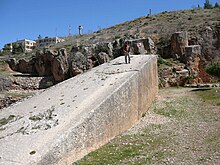Pregnant woman stone
The Pregnant Woman's Stone ( Arabic حجر الحبلى Hajar al-Hubla , DMG ḥaǧar al-ḥublā ) or Stone of the South is a Roman monolith that is located in Baalbek in Lebanon and is considered one of the world's largest monoliths . Two other, even larger, ancient monoliths were discovered not far from it in the 1990s and 2014. The three limestone blocks were intended as building blocks for the Roman temple complex of Baalbek ,famous for its gigantism, but were never moved from the quarry.
Pregnant woman stone
description
The processed stone block of Cretaceous limestone is
- 20.31-20.76 m long,
- at the bottom 4 m, at the top 4.14–5.29 m wide and
- 4.21–4.32 m high.
With a density of 2.6-2.8 g / cm³, the monolith weighs about 1000 t.
The stone is worked on three long sides and was partly covered by soil for a long time. On the side covered by the soil - called the head side - the large cuboid is not processed, but rather rough. At this end of the stone there is a recognizable groove that may have been used to work the head side at right angles. The foot of the stone block protruding from the sand, as well as the top and the side sides, are finished. The top has been severely smoothed by entering tourists and the processing marks have been leveled there. The stone has a crack in the upper third, which however does not extend through the stone and is not at risk of breaking.
The knight Martin Baumgarten from Kufstein reported about this stone in the early 16th century. Baumgarten noted letters from a Roman inscription on it, possibly referring to an emperor or a deity.
In 1996 the ancient quarry from which the stone block originated was recorded by Austrian scientists from Linz and two large stone blocks were digitally measured in order to analyze the processing stages. Since the quarry is 900 meters away from the "Holy District", the temple complex of Baalbek, the view is taken that it belongs to the three monoliths of similar size - the so-called " Trilithos " (not to be confused with the Trilith gate building ) form part of the podium of the Temple of Jupiter . These three monoliths, which were built into the temple of Jupiter, weigh an average of 800 tons.
Transportation problem
How the stone transport of the limestone block was ultimately intended is not clear. It can be assumed that it was not planned on wooden rollers or sledges, as these would have been crushed or sunk into the sandy soil. However, it is quite possible to transport stones with extremely large masses: This is pushed into the realm of possibility by scientists with the example of the erection of the obelisk on St. Peter's Square in 1586 with 48 winches, 900 workers and 75 horses.
Naming
The size of the stone gave rise to myths . According to Arabic legends, it indicates the beginning of the human race. Furthermore, extraterrestrial beings are brought into connection with the stone and reference is made to pre-Roman mythical beings and cultures.
More monoliths
Unnamed Monolith I
Another, even larger, monolith was discovered accidentally in the 1990s. The building block, which is also made of Cretacian limestone, weighs 1242 t according to the calculations of the Linz scientists.
Assuming that the rectangular block continues underground in the non-visible areas, its dimensions are:
- 19.5-20.5 m in length
- 4.34–4.56 m width
- 4.5 m high
Unnamed Monolith II
When the pregnant woman's stone was uncovered in 2014, a Lebanese-German research team discovered another monolith with an estimated mass of around 1650 t and the following dimensions:
- 19.6 m length
- 6 m width
- at least 5.5 m high
This is the largest known stone block from ancient times.
Individual evidence
- ↑ a b Ruprechtsberger 1999, p. 15.
- ↑ Ruprechtsberger 1999, p. 20.
- ↑ Adam 1977, p. 52.
- ↑ a b c d Ruprechtsberger 1999, p. 17.
- ↑ Lebanese-German research team discovers the world's largest ancient stone block in Baalbek. German Archaeological Institute , November 21, 2014, accessed on November 23, 2014 .
literature
- Jean-Pierre Adam: Speaking of you trilithon de Baalbek. Le transport et la mise en oeuvre des mégalithes. In: Syria. Vol. 54, No. 1/2, 1977, ISSN 0768-2506 , pp. 31-63, online .
- Erwin M. Ruprechtsberger : From the quarry to the Jupiter temple of Heliopolis / Baalbek (Lebanon). In: Linz archaeological research. Vol. 30, 1999, ZDB -ID 521657-6 , pp. 7-56.
Web links
- Lebanon - 1997 preliminary report by Erwin M. Ruprechtsberger ( Memento from February 12, 2005 in the Internet Archive )
Coordinates: 33 ° 59 '54.4 " N , 36 ° 11' 55.7" E




